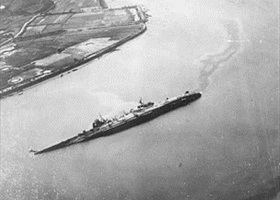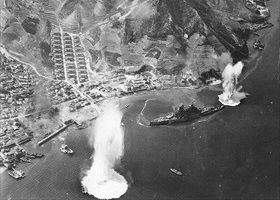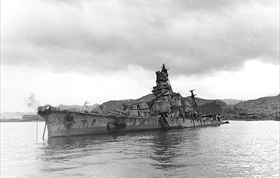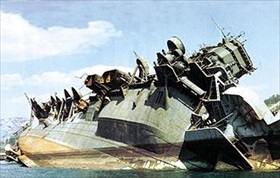HIROHITO’S “MOBILE FLEET” IMMOBILIZED
Aboard the USS Shangri-La · July 28, 1945
The Imperial Japanese Navy had the second most powerful navy in the Pacific Theater in World War II and the third largest navy in the world after the U.S. and Royal navies. During the first years of the war the Japanese Combined Fleet, the IJN’s main ocean-going component, dominated the Western Pacific with the world’s largest aircraft carrier fleet (21 fleet carriers and 4 light carriers), 12 battleships (including the world’s largest, the 64,000‑ton Yamato), 141 destroyers, and 117 submarines. As the war situation in the Pacific progressively worsened for the Japanese, the territories controlled by its “Area Fleets” fell one by one to the U.S. Navy, Army, and Marines.
On this date in 1945 Vice Adm. John S. “Slew” McCain’s carrier flagship, Shangri-La, began a series of tailhook attacks on the remnants of the Combined Fleet anchored in the Japanese naval base at Kure Harbor south of Hiroshima on the main island of Honshū. Carrier aviators flying Curtiss SB2C Helldiver dive bombers and Vought F4U Corsairs had mauled Kure earlier in March. Now the Japanese fleet lay impotent and rusting in its anchorage, lacking sufficient fuel, aircraft, and trained air crews to harm the U.S. Pacific Fleet. The well-publicized July 1945 raids (July 24–26 and today’s on the 28th) clobbered prime Japanese targets: three battleships, a new aircraft carrier, two heavy cruisers, other warships, even tankers and a merchant ship. Thrown into the bargain were nearly 700 Japanese aircraft destroyed or damaged.
The Kure raids were also controversial. McCain and his staff, but not higher-ups Adm. William “Bull” Halsey and Fleet Admiral Chester W. Nimitz, opposed the raids because the Japanese ships in Kure Harbor had been reduced, for all intents and purposes, to serving as floating antiaircraft batteries. That said, as a result of July’s three raids on Kure 170 aviators received Navy Crosses, the most since the four-day Battle of Midway in 1942 yielded 154 Navy Crosses to Navy men and Marines, against a loss of 83 Navy airmen. After the October 1944 Battle of Leyte Gulf had ended the offensive capability of Japan’s once-feared First Mobile Fleet (Dai-Ichi Kidō Kantai), Americans mocked the entire Japanese Combined Fleet as the “immobile fleet.” By the end of July, the “immobile fleet” was a hapless, ineffective combat force.
[amazon_carousel widget_type=”ASINList” width=”600″ height=”200″ title=”Recommended Reading” market_place=”US” shuffle_products=”False” show_border=”False” asin=”1472801466,0815411189,1591142199,1847252370,0099356007,0141001461,0671792172,1591145791,0812968581,0743252225″ /]
U.S. Navy’s Kure Harbor Blitz, July 1945
 |  |
Left: On March 19, 1945, Vice Admiral (later Admiral) Marc Mitscher’s Task Force 58 aircraft carriers made the first carrier attack on the Kure Naval Arsenal. On July 24 U.S. Task Force 38 launched a massive attack to destroy any and all remaining units of the Imperial Japanese Navy. Two-year-old light cruiser Ōyodo, flagship of Vice Admiral Jisaburō Ozawa’s Combined Fleet, was strafed and hit by four 500‑lb bombs. Four days later the Ōyodo was hit by four more bombs and capsized in shallow water. About 300 crewmen were killed, while her remaining crew abandoned ship.
![]()
Right: Aviators from the carriers Shangri-La and Wasp concentrated on the battleship Haruna during their raid on Kure Harbor on July 28, 1945. Bombed more than any other Japanese battleship, the Haruna had been seriously damaged four days earlier, but this time she was holed on her port side, took on tons of water, and sank next to the pier with the loss of 65 of her 1,360 crew.
 |  |
Left: In October 1944 the Japanese heavy cruiser Aoba was attacked in Manila, the Philippines, by carrier-based planes from Task Force 38. In December the Aoba limped into Kure Harbor, was declared irreparable, and turned into a reserve ship. During the U.S. air raid on Kure in April 1945, the Aoba was further damaged and settled in shallow waters. Hit again on July 24 and 28, 1945, she was a total loss.
![]()
Right: The keel of the carrier Amagi was laid down in October 1942, and she was completed in August 1944. On March 19, 1945, the carrier was lightly damaged by aircraft from Task Force 58. A month later she was permanently moored at an island in Kure Harbor and extensively camouflaged. The Amagi was bombed again on July 28, but she had been abandoned four days earlier. The Amagi’s sister carrier, the Katsuragi, was mauled in the same air raid by a one‑ton bomb that blew out 20 ft of her port hull and 30 ft of her flight deck. The Katsuragi was used after the war to return thousands of Japanese soldiers and civilians to the Home Islands.
Contemporary Footage Showing Off the Ships and Men of the Imperial Japanese Navy
![]()

 History buffs, there is good news! The Daily Chronicles of World War II is now available as an ebook for $4.99 on Amazon.com. Containing a year’s worth of dated entries from this website, the ebook brings the story of this tumultuous era to life in a compelling, authoritative, and succinct manner. Featuring inventive navigation aids, the ebook enables readers to instantly move forward or backward by month and date to different dated entries. Simple and elegant! Click
History buffs, there is good news! The Daily Chronicles of World War II is now available as an ebook for $4.99 on Amazon.com. Containing a year’s worth of dated entries from this website, the ebook brings the story of this tumultuous era to life in a compelling, authoritative, and succinct manner. Featuring inventive navigation aids, the ebook enables readers to instantly move forward or backward by month and date to different dated entries. Simple and elegant! Click 











